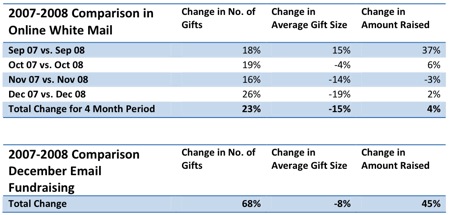In December of 2008, we published an article showing that online giving had grown significantly between the fall of 2007 and the fall of 2008.1 We decided to take one more look at these trends—the election is over, the economic crisis has deepened and end-of-year fundraising data is available.
As before, we looked at online giving for five nonprofit clients, including Easter Seals, Habitat for Humanity International, National Multiple Sclerosis Society, Oxfam America, and The Wilderness Society. For all five clients, we looked at their online ‘white mail’ – unsolicited gifts via the organization’s main donate page – for September, December and their end-of-year fundraising email marketing.
The data below represents the average changes in giving, year over year, for the five organizations.
Our analysis showed:
- The number of online ‘white mail’ gifts was up by roughly 20% each month of the year as compared to the same month in the previous year. Every one of our study participants saw an increase in the number of ‘white mail’ gifts made online in December of 2008.
- The average gift size for online ‘white mail’ has plummeted, with an average gift in December of 2008 nearly 20% less than the average gift in December of 2007.
- The increase in the number of gifts offset the decline in average gift size, which meant that the nonprofits in our study only saw a 4% increase in overall online giving via white mail when comparing December of 2008 to 2007.
- When we looked at the December email fundraising, however, the increase in the total number of donors was much larger, and the average gift size did not decline as steeply, leading to an increase in the total amount raised via email by the participating nonprofits.
How can nonprofits best adapt to these changes in results? We have a few suggestions:
1) Maximize average gift size where possible. There are a number of ways to help strengthen the average gift size, including:
- Present gift options from high to low (see an example at www.oxfamamerica.org/donate).
- Consider offering a premium with higher dollar gifts to encourage donors to make larger gifts.
- Use giving history to make sure you are asking previous donors for an amount that is equal to or greater than previous gifts. You don’t want to ask your $100 donor to give $35 when they renew their membership!
2) Maximize email fundraising returns. There are two major ways we would suggest maximizing your email fundraising returns, in addition to improving the average gift size:
- Focus your emails on urgent deadlines. We’re seeing that fundraising emails that focus on deadlines that are only 1-2 days away significantly outperform other emails.
- Grow your email list. Email fundraising is partly just a function of who you email, and the larger your list, the more money you will raise (as long as you focus on high quality recruits). Given tight budgets, think about sources that might not cost as much as paid advertising, such as cross-promotions with like- minded nonprofits, marketing your email list via a Google grant or more aggressively collecting email addresses from other channels.
3) Leave no stone unturned. In the past, online fundraising has grown almost effortlessly for some organizations. With online giving slowing down, however, it may be time to try some tactics that don’t produce huge results, but can boost returns during a campaign, or slowly over the course of a year. When running an online fundraising campaign, don’t just send out a series of three email messages. Use every tool at your disposal – start with these, then think of others:
- Promote the campaign on your website’s home page.
- Post about it on your organizational blog.
- Put a ‘P.S.’ in your advocacy alerts linking to the fundraising campaign.
- Run an e-newsletter article.
- Promote it to your Facebook cause.
- Set up a post-advocacy ‘landing page’ that takes petition signers directly to the campaign donation page.
- Produce a compelling online video and host it on your donation page.
- Have a ‘lightbox,’ splash page or other homepage takeover coded and ready to go in case of a media moment or emergency.
- For more ideas, click here (PDF) to read our article about Oxfam America’s 2008 end-of-year fundraising campaign!
Each of these promotions may produce only a fraction of the returns of a standalone email, but they can help you boost overall results.
And most importantly, don’t give up!
We’d like to thank the five nonprofits who generously shared their data for this study: Easter Seals, Habitat for Humanity International, National Multiple Sclerosis Society, Oxfam America, and The Wilderness Society.
QUESTIONS, COMMENTS?
If you have questions about our data or conclusions, or if you would like to discuss your organization’s online fundraising strategy, please don’t hesitate to get in touch with us.
1 https://www.mrss.com/m?r?online?fundraising?and?the?economy?article?amended?02?04?09.pdf




